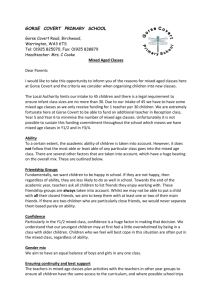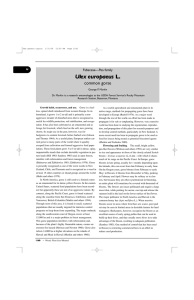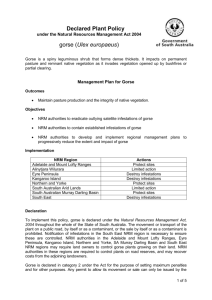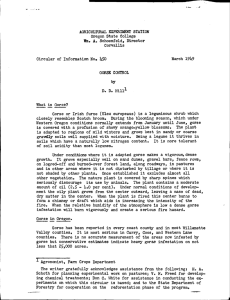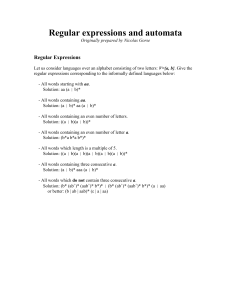Whittlesea weed fact sheet * Gorse/Furze
advertisement
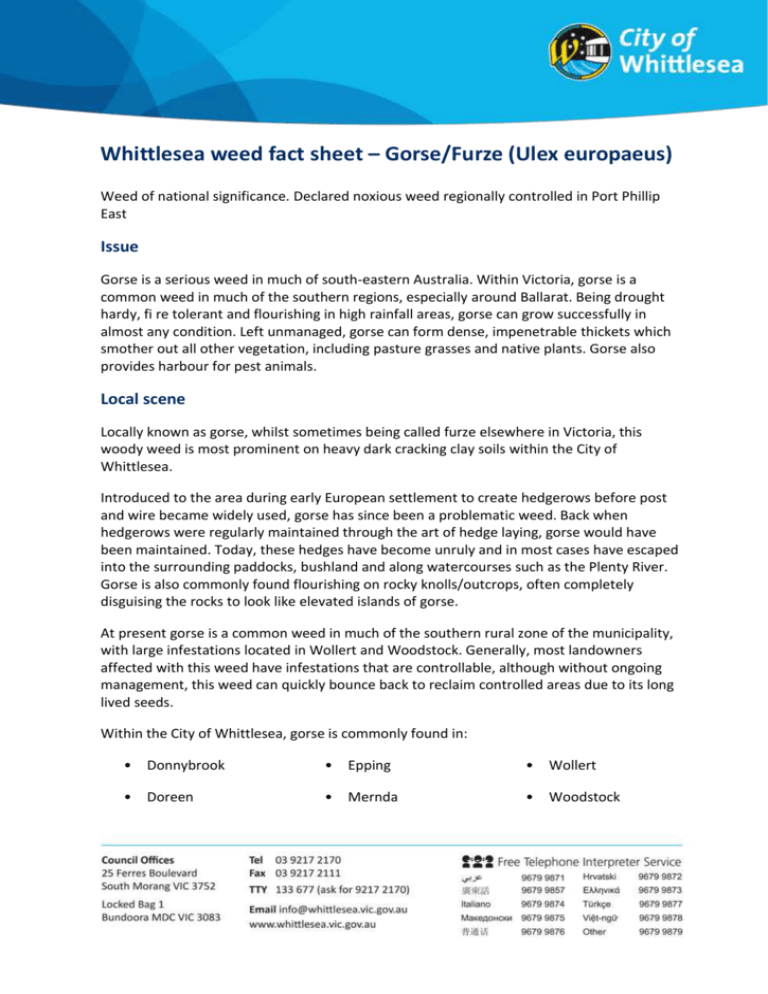
Whittlesea weed fact sheet – Gorse/Furze (Ulex europaeus) Weed of national significance. Declared noxious weed regionally controlled in Port Phillip East Issue Gorse is a serious weed in much of south-eastern Australia. Within Victoria, gorse is a common weed in much of the southern regions, especially around Ballarat. Being drought hardy, fi re tolerant and flourishing in high rainfall areas, gorse can grow successfully in almost any condition. Left unmanaged, gorse can form dense, impenetrable thickets which smother out all other vegetation, including pasture grasses and native plants. Gorse also provides harbour for pest animals. Local scene Locally known as gorse, whilst sometimes being called furze elsewhere in Victoria, this woody weed is most prominent on heavy dark cracking clay soils within the City of Whittlesea. Introduced to the area during early European settlement to create hedgerows before post and wire became widely used, gorse has since been a problematic weed. Back when hedgerows were regularly maintained through the art of hedge laying, gorse would have been maintained. Today, these hedges have become unruly and in most cases have escaped into the surrounding paddocks, bushland and along watercourses such as the Plenty River. Gorse is also commonly found flourishing on rocky knolls/outcrops, often completely disguising the rocks to look like elevated islands of gorse. At present gorse is a common weed in much of the southern rural zone of the municipality, with large infestations located in Wollert and Woodstock. Generally, most landowners affected with this weed have infestations that are controllable, although without ongoing management, this weed can quickly bounce back to reclaim controlled areas due to its long lived seeds. Within the City of Whittlesea, gorse is commonly found in: • Donnybrook • Epping • Wollert • Doreen • Mernda • Woodstock Problem land management practices The worst thing landowners can do with gorse is to leave it unmanaged. Every year each plant can produce copious amounts of seeds which can remain viable in the soil for decades. Left unchecked, the soil seed bank accumulates a huge reserve of seeds, which if not managed properly, could affect many future generations of Whittlesea landowners. Some land management practices contribute to the spread of weeds. Landowners can unintentionally spread gorse by: • Slashing, especially during the peak seeding season • Importing soil or fill that is contaminated with weed seed • Using dirty machinery that is contaminated with soil and weedy material • Disturbing the ground, for example burning or ploughing where Gorse has previously grown will often cause a flush of seedlings to emerge. Burning gorse will not destroy the parent plant, it will only reduce the above-ground canopy. • Failure to undertake follow-up control works after commencing gorse control. • Not implementing an integrated weed control program using more than one method. Refer to the City’s ‘Seasonal Guide to Weed Management’ for information on integrated weed control options. Visit www.whittlesea.vic.gov.au (key word search: seasonal guide) or email Sustainability@whittlesea.vic.gov.au for your copy of the Guide. You may also contact Council’s Sustainable Land Management Officer on (03) 9217 2493 for further advice or for a copy of the Guide. Identification tips Flower/seed: Small, bright, deep-yellow pea flowers present throughout the year, however the most prolific flowering period is late winter to spring. The flowers develop into a green, furry pea-pod which gradually grows to approximately 2.5cm/1 inch and changes to a dark brown, almost black colour on maturing. Once mature, the seed pods will remain closed until a hot, dry day when the capsule will burst open. As the pods burst open, the seeds are propelled a few metres away from the parent plant. Often the cracking and popping of the seed pods can be heard when standing nearby to a gorse plant. The roundish seeds are dark brown in colour and are approximately a couple of millimetres in size or the size of a large mustard seed. Leaves: The spiny leaves are a dark, glossy green growing to approximately 2cm in length and 2mm in width. The leaves are held in small bunches on the stems, however along mature stems, the leaves grow sparsely and often in ones and twos. A distinctive feature of gorse leaves are the sharp tips, which if brushed against, will pierce the skin and cause great pain. Form: Dense woody shrub with numerous branches covered in small, needle-like leaves. Young plants have green stems which are completely covered in leaves. However, mature plants have cracked, beige stems which can form trunks ranging from approximately pencil to ankle thick. Accurate identification is essential. If you are not sure whether you have this weed on your property, contact Council’s Sustainable Land Management Officer for further advice on (03) 9217 2493 or email Sustainability@whittlesea.vic.gov.au. Contacts Australian Pesticide and Veterinary Medicines Authority (APVMA) www.apvma.gov.au Tel. (02) 6272 5852 City of Whittlesea Sustainability Planning Unit www.whittlesea.vic.gov.au Tel. (03) 9217 2493 Department of Primary Industries (DPI) www.dpi.vic.gov.au Tel. 136 186 DPI Chemical Information Service www.dpi.vic.gov.au Tel. (03) 9210 9379 The Gorse Taskforce Tel. 136 186 Further reading Department of Primary Industries – Swan. E & Faithfull. I (October, 2004) Landcare Notes: Gorse / Furze– Management, LC0380 Department of Primary Industries – Swan. E & Faithfull. I (October, 2004) Landcare Notes: Gorse / Furze– Identification, LC0192 Keith Turnbull Research Institute Frankston (November, 1998) Landcare Notes: Biological control of gorse with the spider mite, LC0167 Weeds CRC (2004) Weed Management Guide- Gorse, Ulex europaeus Page 3 of 4 Disclaimer The advice contained in this publication is intended as a source of information only. Always use chemicals in accordance with manufacturer directions on the product label or in Material Safety data sheets available from the manufacturer. The City of Whittlesea and its officers do not guarantee that the publication is without flaw of any kind or is wholly appropriate for your particular purposes and therefore disclaims all liability for any error, loss or other consequence which may arise from your relying on this information. Page 4 of 4
